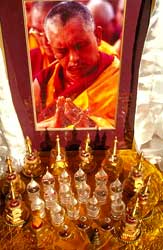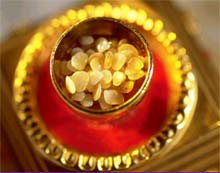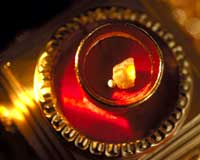Short biographies of the great Buddhist mentors, whose sacred relics you could see on the festival “TIBET”
Kasyapa Buddha Kasyapa Buddha preceded the historical Buddha, Shakyamuni. Kasyapa Buddha was the third of the 1,000 Buddhas of this Fortunate Aeon who, it is predicted will teach the path of peace to humanity. Before him were Buddhas Krakuchand and Kanakamuni. Kasyapa Buddha was born in India in the family of a priest. Like Buddha Shakyamuni he reached enlightenment under the Bodhi tree in the Indian town of Bodhgaya. It is said that all the Buddhas of our Aeon will reach enlightenment in this very town, which has become sacred for the Buddhist pilgrims.
Kasyapa Buddha taught:
"Not to commit any evil actions
To accumulate a wealth of excellent virtue
And to subdue one's own mind -
This is the teaching of the Buddha."
Shakyamuni, the Historical Buddha
Shakyamuni Buddha was born in approximately 563 BCE at Lumbini, which is on the modern border between India and Nepal. Before he became enlightened he was known as Prince Siddharta. Prince Siddharta led the privileged life of royalty. He married Yosodhara and had a son. When he was 29 years old the Prince was traveling outside the palace when he saw the "Four Signs" - these were a sick man, an old man, a corpse and a monk. The prince had previously known only the extreme luxury of palace life and was shocked by what he now saw. He felt compelled to find a way out of the sufferings of life and death. From that moment he renounced his royal life, left his wife and child, and set out to find spiritual teachers. For six years he engaged in very austere practices, but eventually he realized that such practices were not the true path of escape from suffering. He walked to Bodhgaya, took a small, nourishing meal, and with an attitude of discipline and great loving-kindness he sat down beneath a tree vowing not to rise again until he had achieved enlightenment. In the morning, a Buddha arose.
Turning the Wheel of Dharma
The Buddha did not begin to teach immediately after his enlightenment. Upon request, he gave his first teaching seven weeks later. This became known as the 'First Turning of the Wheel of Dharma'. The teaching was about the Four Noble Truths: all life is suffering, the suffering has a cause, the suffering can end and there is a true path to end suffering.
At Vultures Peak, Buddha 'turned the wheel of Dharma' a second time by teaching about the true nature of reality - the emptiness of all phenomena. These teachings are known as the Perfection of Wisdom sutras.
The Buddha turned the Wheel of Dharma a third time at Vaishali and continued to travel and teach for many years. One of the Buddha's great skills was his ability to give teachings according to the capacity of those listening to him. This resulted in a wide variety and number of teachings called sutras. There are said to be 84,000 categories of the Buddha's teachings.
Buddha's Final Teaching
At the age of 80, in Kushinagar, India, the Buddha gave his final teaching. He taught the importance of meditating on impermanence. He said, "All conditioned phenomena are impermanent; subject to decay and disintegration. Work out your own salvations with diligence. This is the last teaching of the Tathagata (Buddha)." He then passed into progressively higher states of meditation into Nirvana (enlightenment).
Lumbini, Bodhgaya, Vaishali and Kushinagar are still foremost among the places of holy pilgrimage for millions of Buddhists today.
Shakyamuni Buddha's Heart Disciples
Maudgalyayana and Sariputra
Maudgalyayana , one of the most famous Buddha’s students, was well-known for his great powers of clairvoyance. Sariputra is remembered as the disciple who asked the most questions about the nature of reality, thus inspiring the Buddha's Perfection of Wisdom discourses. Buddha said about his disciples: “Oh, monks, follow Sariputra and Maudgalyayana, talk to Sariputra and Maudgalyayana. Sage monks help those, who aim at holiness”.
Ananda
Ananda was the Buddha's cousin and served as his personal attendant for 25 years. He reached enlightenment soon after Buddha was gone. There’s astory about him: “One day when Ananda was passing a well near a village, he asked Pakati, a young outcaste woman, for water. Pakati replied, "O monk, I am too humbly born to give you water to drink. Do not ask for my service lest your holiness be contaminated, for I am of low caste." Ananda said, "I ask not for caste but for water." Pakati's heart leapt with joy and she offered water to Ananda. Having heard that Ananda was a disciple of the Buddha, the woman beseeched the Buddha, "O Lord, help me and let me live in the place where your disciple Ananda dwells so that I may see him and serve him, for I love Ananda." Buddha understood her heart and said, "Pakati, your heart is full of love, but you do not understand your own sentiments. It is not Ananda that you love, but his kindness. Accept the kindness that you have seen him practice toward you and practice it toward others".
Nagarjuna
Nagarjuna was an Indian Pandit who realized that very few people understand the true nature of reality as taught in the Buddha's Perfection of Wisdom Sutras. He knew that if this is not understood there is no way to attain enlightenment and thereby, freedom from suffering. So he composed five treatises, explaining the teaching of madhyamakas, known as “The Middle Path”. Its essence is that the ultimate and conventional truths do not contradict, but supplement each other. Nagarjuna demonstrated that although even the smallest imaginable part of an atom does not exist unconditionally (ultimate truth), cause and effect is incontrovertible (conventional truth), therefore, ultimate truth and conventional truth co-exist.
Bodhisattva Chophak
This great master was known for his steadfast guru devotion. According to the Sutra of this Fortunate Aeon, Bodhisattva Chophak attained such realizations that he could actually see the Buddhas, yet he continued to search for his own guru. His name means "to cry often", which he did because he longed to receive the teachings he needed to progress further on the spiritual path.
When he eventually found his guru who was inside a temple, Bodhisattva Chophak did not immediately enter the temple but first swept and cleaned outside the temple out of respect for his guru.
Yeshe Tsogyel
Yeshe Tsogyel was a Tibetan Princess who lived during the 9th century and became a yogini (female meditation master). Yeshe Tsogyel was the wife of the great Guru Padmasambhava was the founder of Buddhism in Tibet and is the source of the Terma tradition of the Nyingma lineage of Tibetan Buddhism. Yeshe means "primordial wisdom" and Tsogyel means "queen of the ocean-like quality of the mind". She had a special power to see in any life situation the opportunities for new spiritual achievements. She transcribed Padmasambhava's many esoteric teachings onto paper scrolls and concealed them in different places. These hidden Dharma treasures, destined for rediscovery at the correct time, are known as terma. These relics are fragments of two letters written by Yeshe Tsogyel to Padmasambhava.
Lama Atisha
Lama Atisha (982 to 1054 CE) was born a prince in Bengal, in eastern India. He became the most learned scholar at Nalanda Monastery in India, which was the greatest university of Buddhist philosophy of all time. Out of great compassion for the Tibetan people Lama Atisha travelled to Tibet in 1042 CE to revitalise Buddhism there by passing on an unbroken lineage of the Buddha's teachings to the Tibetan people. While he was in Tibet, Lama Atisha wrote the renowned Buddhist text, "Lamp on the Path to Enlightenment". This text is important because it made available for the first time all of Lord Buddha's teachings as an integrated and systematized path of practice.
Milarepa
Milarepa was born in 1052 CE and named Thopaga, which means "delightful to hear". His wealthy father died when Milarepa was very young and his uncle stole the family's inheritance. At his mother's request, Milarepa learned the black arts, killing many people associated with his uncle. Later, Milarepa repented and sought a spiritual teacher. He found Marpa the Translator who treated him very harshly.
For a long time Marpa refused to give any teachings to Milarepa, giving him instead a series of increasingly arduous and frustrating tasks as a means of purifying Milarepa from the effects of having brought so much harm to others. For instance, he ordered Milarepa to build a house by hand and when it was completed, ordered him to tear it back down so that he could move it a short distance and build it all over again. Milarepa built and demolished a number of houses in this way.
Marpa then gave Milarepa many teachings and initiations. Milarepa practiced for many years with great energy while living alone in a cave and eating only nettles. Under Marpa's guidance he reached enlightenment in spite of the great harm he had created early in his life.
Milarepa is famous for the many songs he composed to explain his spiritual realizations.
"Meditate in the unborn nature of the mind:
Like space, no centre, no limit;
Like the sun and moon, bright and clear;
Like a mountain, unmoving, unshakeable;
Like the ocean, deep, unfathomable."
- Milarepa
Lama Tsongkhapa
Lama Tsongkhapa (1357 to 1419 CE) was born in the Tsong Kha region of Amdo Province in eastern Tibet. He was famous for his dedication to vigorous practice. He completed 3,500,000 full-length prostrations, leaving an impression of his body on the floor of the temple. He had visions of Manjushri, the bodhisattva of enlightened wisdom.
Lama Tsongkhapa is the founder of the Gelug tradition of Tibetan Buddhism. He wrote many learned treatises and commentaries on the classic texts such as the lam rim (the stages on the path).
At the age of 62, very early in the morning while sitting in full lotus posture, Lama Tsongkhapa's breathing stopped. Many disciples present witnessed light rays emanating from his body, leading them to believe that he had entered the bardo (the stage between death and rebirth) as an enlightened being.
He taught:
"If you knew how hard it is to acquire,
Living the average life would be impossible.
If you saw its great benefits,
You would be sorry if it stayed meaningless.
If you thought about death,
You would make preparations for your future lives.
If you thought about cause and effect,
You would stop being reckless."
Gyalwa Ensapa
Gyalwa Ensapa was a great Kadampa master (1505 - 1566 CE) born in Ensa, at Hlaku near the Tsang River in Tibet. He felt nothing but revulsion towards every situation he saw in the world, while also feeling overwhelming compassion for every being. He met each one with the thought, "How can I rescue this poor being from the prison of uncontrolled rebirth in cyclic existence?"
Gyalwa Ensapa went to Pema Chan to practice samadhi (concentration). He practiced in deserted foothills and isolated ravines and did not worry about how long it would take nor about the tremendous effort that would be required. Before he was 21 years old he achieved the ability to remain in samadhi day and night. As a result, whenever he did any activity he experienced a unique bliss. His Holiness the First Karmapa
The spiritual leader of the Kagyu tradition of Tibetan Buddhism is His Holiness the Karmapa, who is considered to be the embodiment of all the blessings of the lineage. Each successive Karmapa leaves a letter predicting the precise details and circumstances of his next rebirth.
The Kagyu lineage traces its roots from Shakyamuni Buddha to Tilopa, Naropa, and Marpa the Translator to the renowned Milarepa. Milarepa's student, Gampopa, transmitted the teachings to the First Karmapa, Dusum Khyenpa.
The first Karmapa died when he was 84. His heart was found intact in the funeral pyre and some of his remaining bones had manifested into images of the Buddhas.
Gwang-Chin Master
Master Gwang-Chin was born Huang Wen Lai in 1892 in Hui-An county, Fukien Province, China. Due to his family's extreme poverty he was sold to the Lee family. The Lees were not wealthy either and had a fruit growing business that allowed them to barely scrape together a living. His parents died in 1902 when he was just 11 years old. He realised how impermanent human life was and took refuge with Master Ray-Fang of Cheng-Tien Monastery in Chuen-Jo. In 1927 he took ordination at Cheng-Tien Monastery.
From the very beginning he was an ascetic practitioner. In the monastery one of his duties was to ring the morning wake-up bell. One morning he over-slept and missed ringing the bell at the correct time. After that he never lay down to sleep for the rest of his life. At the age of 95, on the first day of the Chinese New Year, he called together all of his disciples who were in charge of his different monasteries. He told them that he would pass away soon and that they should divide his relics among Cheng-Tien Monastery, Gwang Ming Yen and Miaou Tong Nunnery. Then he went Miaou Tong Nunnery.
On the fifth day of Chinese New Year, with all his disciples gathered around him he told them to recite Amitabha Buddha's name. He said, "There is no coming and no going, nothing is happening." Then he smiled at his disciples and closed his eyes. He was so still that his disciples checked and discovered that he had passed away amidst the Amitabha chanting. The disciples had received his final teaching.
His Holiness the 14th Dalai Lama
His Holiness the 14th Dalai Lama (which means "Ocean of Wisdom") was born on 6 July 1935 to a peasant family living in the small village of Taktser in the province of Amdo, situated in the far northeast corner of Tibet.
At the age of two he was recognized as the reincarnation of the previous Dalai Lama and was formally enthroned at the Potala Palace, Lhasa, in the winter of 1940. At 16 years old, in the wake of Communist China's invasion, he assumed full political responsibility in Tibet. On 31 March 1959 he was forced to flee from Tibet to Dharamsala, India and has lived in exile ever since.
His Holiness has said that not a day goes by when he does not think of the plight of the Tibetan people, but he remains committed to a peaceful resolution with China. He says:
"In my own experience the most difficult period in one's life is the period of greatest gain in knowledge and experience. If you go along in an easy way, with everything okay, you feel everything is just fine. Then one day when you encounter problems you feel depressed and hopeless. Through a difficult period you can learn, you can develop inner strength, determination and courage to face problems.
"Who gives you this chance? - Your enemy. This does not mean that you obey or bow down to your enemy. In fact, sometimes according to the enemy's attitude, you may have to react strongly - but, deep down, calmness and compassion must not be lost. This is possible."
In 1989 His Holiness was awarded the Nobel Peace Prize.
His Holiness is considered by Tibetans and many other Buddhists around the world to be the earthly embodiment of Chenrezig, the Buddha of Compassion. Although he repeatedly insists that he is "just a simple monk" his special qualities are evident. A highly respected scholar and author as well as an accomplished meditator, His Holiness continually shows compassion, humility, humour, and an obvious delight in meeting people everywhere. Texts are taken from the booklet «Heart Shrine Relic Tour» in concordance with the authors. |
![]()
![]()
![]()
![]()


